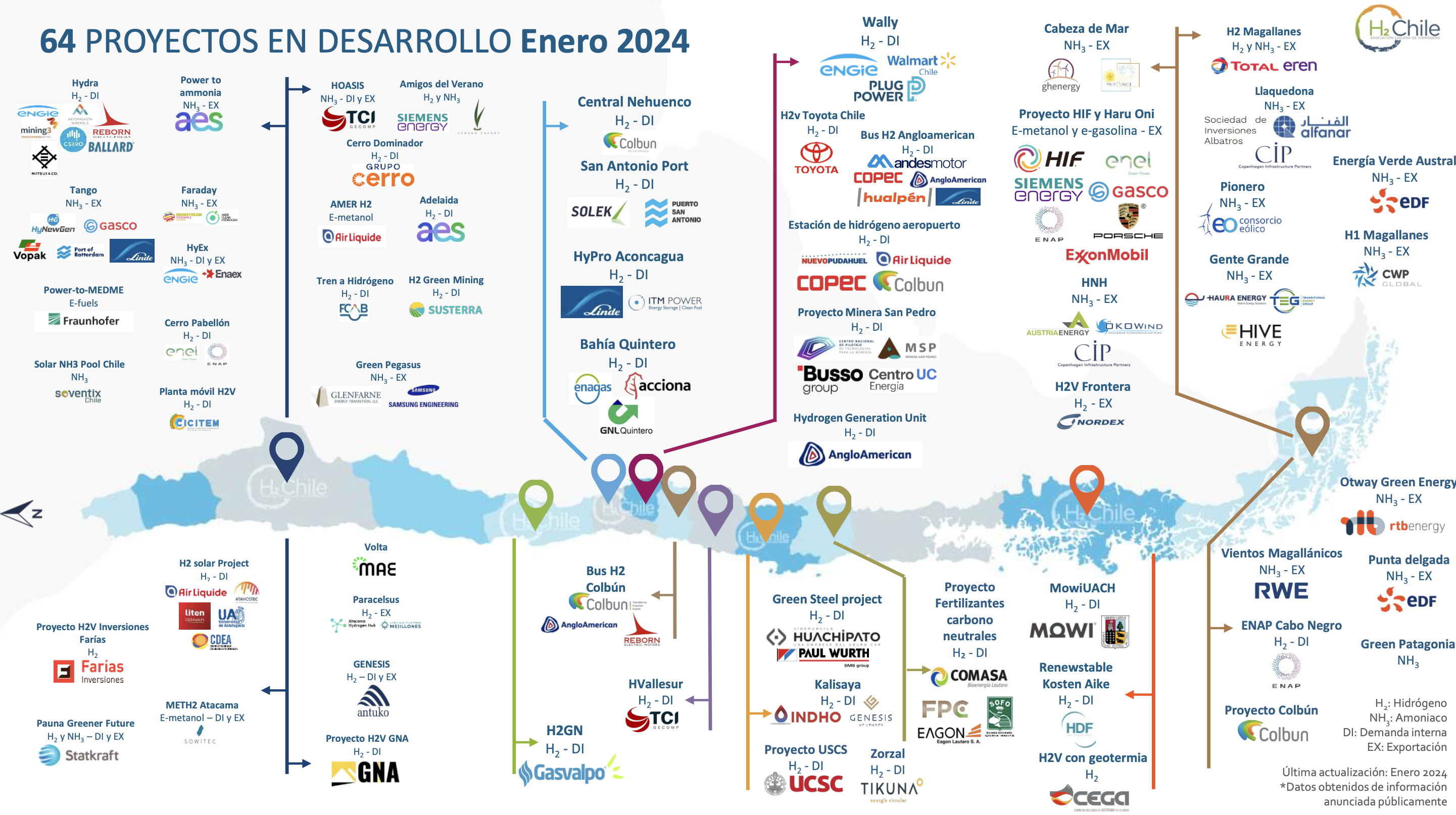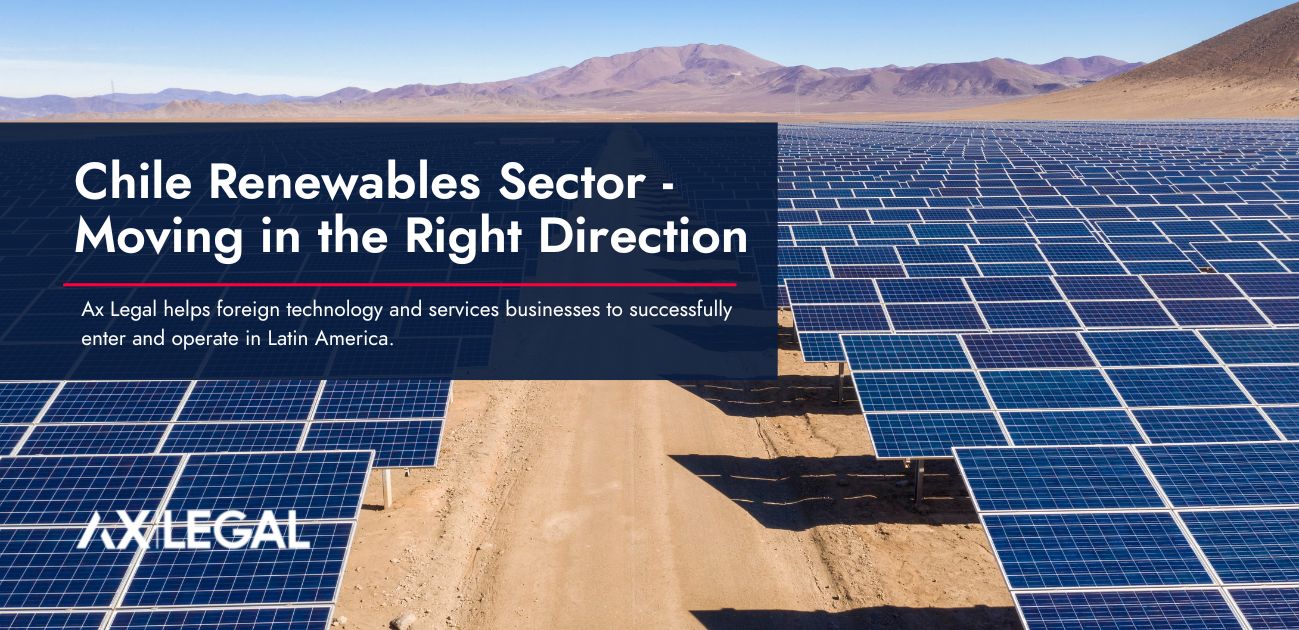Chile Hydrogen Pipeline Update
In 2020, Chile released its national green hydrogen strategy, which set out to make the country the top destination for hydrogen investment in Latin America by 2030.
The goal is to have at least 25 GW of electrolysis capacity operating, producing at least 200k/tons of hydrogen per year, and reaching a price of US$1.50 per kilogram. Achieving this would mean that Chile has the cheapest production on the planet by 2030, one of the main global exporters, and will be a leading global producer measured by electrolysis.
The development roadmap used in the national hydrogen strategy envisions three stages. The first focuses on large-scale domestic consumption through existing demand, for example in refineries. The second stage would spread hydrogen use to the transport sector and exports. The third stage would involve large-scale deployment of export infrastructure.
The Chilean hydrogen industry has broad support across private industry and government stakeholders. Private industry has shown there is an appetite for projects and government is making changes to project permitting that will reduce timelines.
Although there has been only demonstration plants and other pilots operatings to date, there is around 60 projects that have been announced, worth billions of dollars in investment. This year there will be five or six large-scale projects that will enter the environmental impact assessment system.
Industry Group, Hydrogen Chile, have stated that the announced projects have a nominal power capacity of 26.4 GW of electrolysis. 47% of the projects are oriented towards domestic demand and approximately 28% towards exports, while the remaining portion has not yet been specified.

- Mixing small amounts of hydrogen with gas used for home cooking in Coquimbo,
- Fueling forklifts in Walmart distribution centers
- Producing and Fueling a forklift at Anglo American’s Las Tortolas operation
- Chile’s first hydrogen train
- Minera Centinela tests stationary drive train for large mining trucks
- Chile utility company to cool a power plant using hydrogen.
Haru Oni – HIF Global
HIF, which includes Porsche and Enel have already built an e-fuels demonstration plant Haru Oni in Magallanes, the first of its kind in the world.
The company recently submitted to environmental authorities the US$830mn project that will produce e-methanol which then can produce e-gasoline and e-liquified gas. E-gasoline can be used in petrol cars without any mechanical adaption work needed. E-methanol can be used as a chemical feedstock or fuel.
The project inolve building facilities to produce up to 173,000 tonnes of e-methanol per year. The project also includes a separate wind farm that will have 384 MW of installed capacity that needs to be resubmitted to authorities. Construction ork is penciled in to start in November 2024 and take up to 26 months.
The most recent news that the National Petroleum Company ( ENAP ) and HIF Global signed a memorandum of agreement to make the use of carbon neutral fuels, or e-fuels, viable in Chile, and to advance over the coming months in the joint development of a business model that allows commercializing this type of products.
The alliance projects the generation and commercialization of between 22.5 million and 37.5 million liters of e-gasolines from the plant that HIF will build, which would represent between 30% and 50% of the production estimated annual of this company.
H2 Magallanes – Total Eren
Total Enron unveiled plans last year for a 10GW wind project to power green hydrogen and ammonia production in Chile. The H2 Magallanes facility would be located on land secured by the company on the island of Tierra del Fuego in Chile’s southernmost Magallanes region.
H2 Magallanes will consist of a giant wind farm, hydrogen production plant with up to 8GW of electrolysis capacity, a desalination plant, an ammonia plant, and port facilities to transport green hydrogen to markets around the world. Investment could reach ip to USD$15b.
It expects to produce 800,000 tonnes of green hydrogen and export 4.4 million tonnes of ammonia a year. The construction phase could require up to 5,000 people, while the operation could require 1,000.
Currently, the project is in conceptual engineering development and the company has stated that the Environmental Impact Study (EIS) is expected to be delivered by the end of 2024.
Gente Grande
The Gente Grande project will be located in Magallanes region of Chile. The project proposes the production of between 1.3 and 1.5 million tons green hydrogen, powered by 300 wind turbines.
The project is expected to have a cost of USD$6b which includes the construction of a wind farm, a desalination plant, a green hydrogen and ammonia production plant, and port facilities that allow the export of this energy source. There will be 6000 jobs created at the peak of construction and 600 jobs in the operational stage.
In 2023, Transitional Energy Group and Hive Energy entered a joint venture agreement for the development of the project. The partnership concluded a US$20mn funding round which has also been supported by private investors as well as the middle east construction leader, CCC.
The funds will cover all costs for the pre-construction phase of the project, including the environmental assessments already in progress, permitting and preliminary engineering, ensuring “ready to build” status can be achieved by late 2024.
It is still early stages in terms of Chile strategy to become a hydrogen leader. There are still many hurdles to overcome such as regulatory issues, permitting times, transportation infrastructure, and lowering the cost of electrolysers.
To date, the approach has been to start with smaller demonstration plants and pilots to promote the use of hydrogen locally. The goal is to create a local market for hydrogen that will assist initial project owners with finding off-takers, creating the right conditons for projects to recieve financing.
We see this with announcements of companies wanting to blend hydrogen with natural gas that is being delivered to houses, the replacement of grey hydrogen in power plants and refineries, using hydrogen to produce for green ammonia for the local mining industry, or using hydrogen in steel making. Creating local demand is an important step since it will take time for the global hydrogen market to develop.
The Chilean government has recognized that they need to move from supporting supply side measures to supporting demand. The industry is at a point where costs have not yet come down to make hydrogen competitive, yet the industry cannot mature and lower costs without having customers to support them.
Chile’s success will largely depend on how well it can nurture and create the right conditions for large scale investments.
Ax Legal helps industrial technology, engineering, and service companies to navigate the legal and commercial aspects of operating their business in Latin America. With deep knowledge of the industrial and natural resource sectors, we provide actionable and practical advice to help streamline our clients’ entries into Latin America, improve how they operate in the region, and to protect their interests.
Over the years, our team of legal and commercial advisors have developed a track record of working with companies of all sizes from Australia, Canada, the U.S., and Europe. The one common factor that connects our clients is that they are leaders in their field, providing innovative technologies and services to the industrial sectors.
To better understand how we can support you in the Region, please contact Cody Mcfarlane at cmm@ax.legal




 Santiago
Santiago Sydney
Sydney Lima
Lima